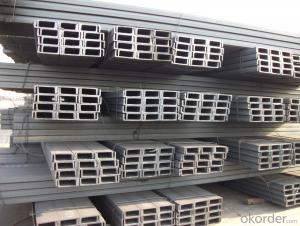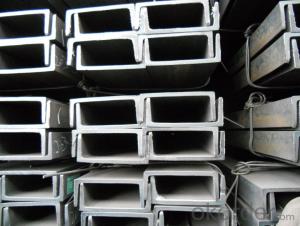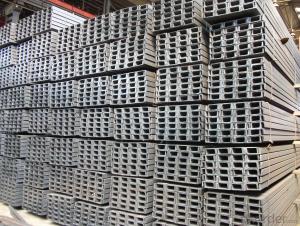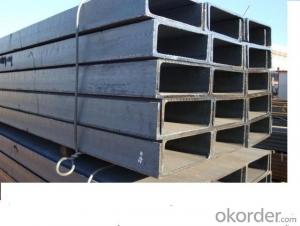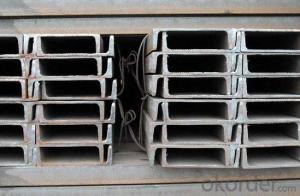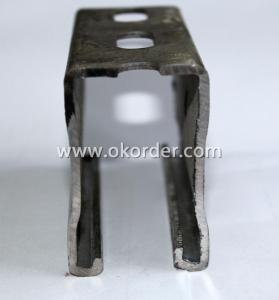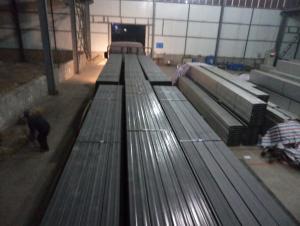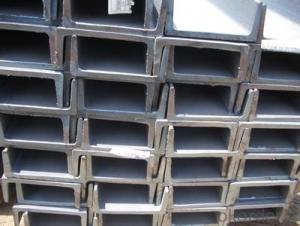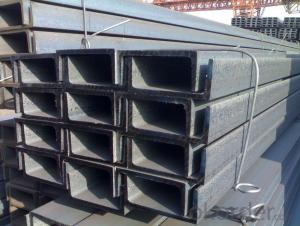High Quality 20# Steel Channel
- Loading Port:
- China Main Port
- Payment Terms:
- TT OR LC
- Min Order Qty:
- -
- Supply Capability:
- -
OKorder Service Pledge
OKorder Financial Service
You Might Also Like
Steel Channel
Standard: GB
Material: Q235
Length: 6m, 12m
Size:
| Size (mm) | Mass (Kg/m) |
| 200*73*7.0 | 22.637 |
| 200*75*9.0 | 25.777 |
The chemical composition of HR Channel Steel according to Q235B is shown in Table-1.
Alloy No | Grade | Element(%) | ||||
C | Mn | S | P | Si | ||
Q235 | B | 0.12-0.20 | 0.3-0.7 | ≦0.045 | ≦0.045 | ≦0.3 |
Table-1
Note: we are able to present our customers relevant SGS test report for chemical composition of HR Channel Steel.
The mechanical property of HR Channel Steel according to Q235B is shown in Table-2
Alloy No | Grade | Yielding Strength Point(Mpa) | |||
Thickness(mm) | |||||
≦16 | >16-40 | >40-60 | >60-100 | ||
≧ | |||||
Q235 | B | 235 | 225 | 215 | 205 |
Table-2
Package & Delivery of MS Channel:
1.The hot rolled channel steel will be packed in bundle with steel wire at each end of every bundle and color marking in order to help the customer to recognize his goods more easily at sight.
2. And the hot rolled channel steel could be loaded into 20ft or 40ft container, or by bulk cargo.If the weight of each bundle reaches more than 3.5 mt, the loading by break bulk cargo should be choosed.When the weight of each bundle reaches less than 3mt, the loading by container should be choosed.
3.As for the transportaion from mill to loading port, the truck will be usually used. And the maximum quantity for each truck is 40mt.
4.All in all, we could do in accordance with customer's request.
*If you would like to get our price, please inform us the size, standard/material and quantity. Thank you very much for your attention.
- Q: Can steel channels be used in infrastructure projects?
- Infrastructure projects can utilize steel channels effectively. These channels are commonly employed in construction and infrastructure projects as they serve as a versatile and widely used structural component. Their primary purpose is to provide support and stability to structures like bridges, buildings, and highways. The use of steel channels in infrastructure projects offers several advantages. Firstly, they possess exceptional strength and durability, enabling them to withstand heavy loads and harsh weather conditions. This ensures the long-term integrity and stability of the infrastructure. Moreover, steel channels can be easily fabricated and tailored to meet specific project requirements. They are available in various sizes, shapes, and thicknesses, allowing engineers and architects to design and construct structures with precision. Furthermore, steel channels exhibit excellent resistance to corrosion. This is particularly important in infrastructure projects that are exposed to moisture or adverse environmental conditions. By galvanizing or applying protective coatings, steel channels can prevent rust and corrosion, thereby prolonging their lifespan. Additionally, steel channels offer cost-efficiency. When compared to other construction materials like concrete or wood, steel channels have a longer lifespan and require less maintenance. As a result, the overall maintenance and replacement costs of infrastructure projects are reduced, making steel channels a cost-effective choice. In conclusion, steel channels are extensively used in infrastructure projects due to their strength, durability, customization options, corrosion resistance, and cost-efficiency. They play a crucial role in providing support and stability to various structures, making them a reliable choice for engineers and architects involved in infrastructure development.
- Q: How do steel channels contribute to the overall energy efficiency of a structure?
- There are several ways in which steel channels can enhance the overall energy efficiency of a structure. To begin with, steel channels are frequently utilized in the construction of walls and roofs, providing structural support and evenly distributing the building's weight. By incorporating steel channels, the structure's overall weight can be reduced, resulting in lower energy consumption during construction and throughout the lifespan of the building. Moreover, it is possible to design steel channels in a manner that imparts insulation properties. Thermal bridging, which involves the transfer of heat through materials with high thermal conductivity, is a common issue in buildings. However, by engineering steel channels to minimize thermal bridging through the inclusion of insulation materials or thermal breaks, the transfer of heat between the building's interior and exterior can be reduced, thereby improving energy efficiency. Furthermore, steel channels are renowned for their strength and durability. This enables the construction of larger spans and open spaces, eliminating the need for additional support columns or walls. By maximizing the utilization of open areas, natural light and ventilation can be optimized, reducing reliance on artificial lighting and mechanical HVAC systems. This not only decreases energy consumption but also enhances the comfort and well-being of occupants. Lastly, one advantage of steel channels is their recyclability. Steel is one of the most recycled materials globally, and incorporating recycled steel channels into construction projects can significantly diminish the environmental impact. The energy required to produce recycled steel is considerably lower compared to the production of virgin steel, further contributing to the overall energy efficiency of the structure. In conclusion, steel channels play a crucial role in enhancing the overall energy efficiency of structures by reducing weight, minimizing thermal bridging, enabling open spaces for natural lighting and ventilation, and being recyclable. By incorporating steel channels into construction, buildings can achieve superior energy performance, reducing energy consumption, and promoting sustainability.
- Q: What does "deformed L/200" mean in the carrying capacity of channel steel?
- This refers to deflection, deflection is the force or non-uniform temperature changes, the axis of the rod in the direction perpendicular to the axis of the line displacement, or plate surface in the vertical direction of the middle direction of the line displacement. L/200 is the maximum amount of deformation produced per 200mm length. That is to say, the lowest point after the force is divided by the size of the origin by the ratio of the length L. For example, the length is 3M, the maximum deformation can not exceed 3000/200=15mm, but there is a premise that the force can be deformed, but after the removal of force, it must rebound to the original standard is effective, otherwise it is invalid.
- Q: Can steel channels be used in the automotive industry?
- Yes, steel channels can be used in the automotive industry. Steel channels are versatile and commonly used in various applications within the automotive sector. They are frequently employed in the construction of car frames, chassis, and other structural components. The high strength and durability of steel channels make them ideal for providing support and stability to vehicles. Additionally, steel channels are also utilized in the manufacturing of body panels, seat frames, and other interior components. The use of steel channels in the automotive industry ensures the production of safe and long-lasting vehicles.
- Q: Can steel channels be used for stair treads?
- Yes, steel channels can be used for stair treads. Steel channels are often used in construction for their strength and durability, and they can provide a sturdy and safe surface for stair treads. Steel channels can be designed and fabricated to meet specific load requirements, making them suitable for various types of staircases. Additionally, steel channels can be galvanized or coated to enhance their resistance to corrosion, further increasing their longevity. Overall, steel channels offer a reliable and practical option for stair treads in both commercial and residential settings.
- Q: What are the advantages of using steel channels in construction?
- There are several advantages to using steel channels in construction. Firstly, steel channels are incredibly strong and durable. They have a high strength-to-weight ratio, meaning they can support heavy loads without adding unnecessary weight to the structure. This makes them ideal for use in various construction projects, such as bridges, buildings, and infrastructure. Secondly, steel channels are resistant to corrosion. Unlike other materials like wood or concrete, steel channels do not rot, warp, or degrade over time. They can withstand exposure to harsh weather conditions, chemicals, and moisture, making them suitable for both indoor and outdoor applications. Additionally, steel channels offer great versatility in design and construction. They are available in various sizes, shapes, and configurations, allowing for flexible use in different applications. Steel channels can be easily fabricated and customized to meet specific project requirements, making them adaptable to a wide range of construction needs. Moreover, steel channels are cost-effective in the long run. While the initial cost of steel channels may be higher than other materials, their strength, durability, and low maintenance requirements result in lower life-cycle costs. They do not require frequent repairs or replacements, reducing overall maintenance and replacement expenses over time. Furthermore, steel channels are fire-resistant. Steel is a non-combustible material, meaning it does not contribute to the spread of fire. In the event of a fire, steel channels can provide structural stability and integrity, ensuring the safety of the building and its occupants. Lastly, steel channels are environmentally friendly. Steel is one of the most recycled materials in the world, and using steel channels in construction helps reduce the demand for new raw materials. Additionally, steel is energy-efficient, as it requires less energy to produce compared to other construction materials. In conclusion, the advantages of using steel channels in construction include their strength, durability, resistance to corrosion, versatility, cost-effectiveness, fire resistance, and environmental friendliness. These qualities make steel channels a preferred choice for various construction projects, offering long-term benefits and ensuring the integrity and safety of the structures they are used in.
- Q: Are steel channels suitable for architectural feature elements?
- Yes, steel channels can be suitable for architectural feature elements. Steel channels are versatile and can be used in a variety of architectural applications. They are known for their strength, durability, and ability to support heavy loads, making them a popular choice for structural elements in buildings. In architectural design, steel channels can be used to create unique and visually appealing features. They can be incorporated into building facades, staircases, handrails, and other decorative elements. Steel channels can be customized to different shapes and sizes, allowing architects to create intricate and complex designs. Furthermore, steel channels can be finished in various ways to enhance their aesthetic appeal. They can be painted, powder-coated, or even left exposed for a more industrial look. The versatility in finishes allows architects to achieve the desired visual effect for their architectural feature elements. Another advantage of using steel channels is their ability to withstand harsh weather conditions and resist corrosion. This makes them suitable for both indoor and outdoor architectural applications. Steel channels are also low maintenance, which is an added advantage for architectural features that may be difficult to access for regular upkeep. Overall, steel channels offer a combination of strength, durability, and design flexibility, making them a suitable choice for architectural feature elements. Their ability to support heavy loads, versatility in design, and resistance to weather make them a reliable and long-lasting option for creating visually appealing architectural features.
- Q: Can steel channels be used for platform structures?
- Yes, steel channels can be used for platform structures. Steel channels provide excellent structural support, durability, and load-bearing capacity, making them suitable for constructing stable and reliable platforms.
- Q: What does channel 20# mean?.
- Channel steel is divided into ordinary channel steel and light channel steel. Standard Specification for hot-rolled plain channel steel is 5-40#. Specifications for hot rolled flexible channel steel supplied by supply and demand agreement are 6.5-30#. Channel steel is mainly used in building structures, vehicle manufacturing and other industrial structures, and channel steel is often used in conjunction with i-beam.
- Q: What are the different load distribution techniques for steel channels in roof systems?
- There are several load distribution techniques that can be used for steel channels in roof systems. These techniques help to ensure that the weight and forces exerted on the channels are evenly distributed, reducing the risk of structural failure. One common load distribution technique is the use of purlins. Purlins are horizontal beams that are placed on top of the steel channels, providing additional support and distributing the load more evenly. These purlins can be made of steel, wood, or other materials, depending on the specific requirements of the roof system. Another technique is the use of bridging. Bridging refers to the installation of vertical or diagonal braces between the steel channels to prevent them from twisting or buckling under heavy loads. This technique helps to distribute the load across multiple channels, increasing their overall strength and stability. Additionally, the spacing of the steel channels themselves can also affect load distribution. Increasing the spacing between channels can help to distribute the load more evenly, as it reduces the concentration of weight on individual channels. However, it is important to ensure that the spacing is within the recommended guidelines to maintain structural integrity. Furthermore, the use of load-bearing walls or columns can also contribute to load distribution in roof systems. By providing additional support at specific points along the channels, these load-bearing elements help to distribute the load and prevent excessive stress on individual channels. In summary, the different load distribution techniques for steel channels in roof systems include the use of purlins, bridging, proper spacing of channels, and the incorporation of load-bearing elements. These techniques work together to ensure that the weight and forces exerted on the channels are evenly distributed, reducing the risk of structural failure and ensuring the long-term durability of the roof system.
Send your message to us
High Quality 20# Steel Channel
- Loading Port:
- China Main Port
- Payment Terms:
- TT OR LC
- Min Order Qty:
- -
- Supply Capability:
- -
OKorder Service Pledge
OKorder Financial Service
Similar products
Hot products
Hot Searches
Related keywords
